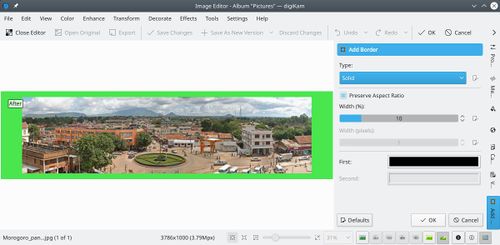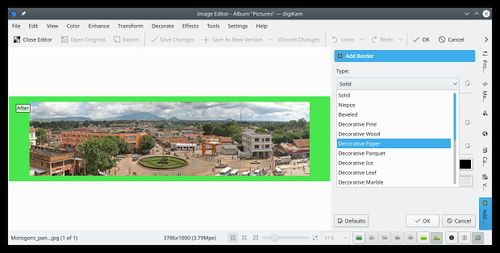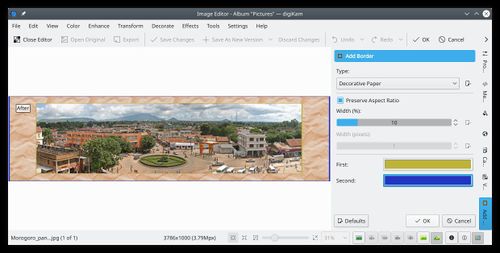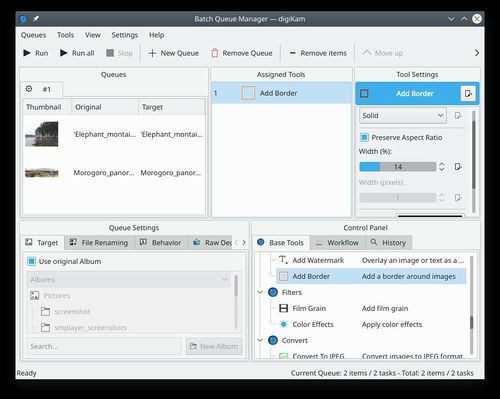Digikam/Adding Borders To Your Photos/de: Difference between revisions
(Created page with "center|500px|thumb Category:Grafik/de Category:Fotografie/de Category:Anleitungen/de") |
(Updating to match new version of source page) |
||
| Line 1: | Line 1: | ||
<languages /> | <languages /> | ||
{{Note|Transcribed from Mohamed Malik's blog, 7 March 2011. This tutorials was updated to the last version of Digikam in January 2019.}} | |||
Viele umrahmen ihre Bilder, seit sie festgestellt haben, dass diese dadurch besser ausschauen und sich dadurch abheben. Mit '''digiKam''' geht das sehr leicht und einfach. | Viele umrahmen ihre Bilder, seit sie festgestellt haben, dass diese dadurch besser ausschauen und sich dadurch abheben. Mit '''digiKam''' geht das sehr leicht und einfach. | ||
| Line 7: | Line 7: | ||
Es gibt zwei Wege um Rahmen zu den Bildern mit '''digiKam''' hinzuzufügen. | Es gibt zwei Wege um Rahmen zu den Bildern mit '''digiKam''' hinzuzufügen. | ||
== Method 1 (Single photo) == | |||
Wählen Sie das Foto aus, dem Sie einen Rahmen hinzufügen wollen und klicken Sie <keycap>F4</keycap> Auf der Tastatur. Das öffnet Ihnen die Bearbeitungsansicht (showFoto). Dort wählen Sie <menuchoice>Decorate -> Bilderrahmen hinzufügen</menuchoice>. | Wählen Sie das Foto aus, dem Sie einen Rahmen hinzufügen wollen und klicken Sie <keycap>F4</keycap> Auf der Tastatur. Das öffnet Ihnen die Bearbeitungsansicht (showFoto). Dort wählen Sie <menuchoice>Decorate -> Bilderrahmen hinzufügen</menuchoice>. | ||
| Line 13: | Line 13: | ||
Es werden Ihnen viele Optionen angeboten | Es werden Ihnen viele Optionen angeboten | ||
One option is the <menuchoice>Solid | One option is the <menuchoice>Solid</menuchoice> color. This option let you choose the color, that you want with [[Special:myLanguage/KColorChooser|KColorChooser]]. | ||
[[ | |||
[[Image:Digikam_Borders2_1.jpg|center|500px|thumb|Attribution image in screenshot: Muhammad Mahdi Karim [http://www.gnu.org/licenses/old-licenses/fdl-1.2.html (GFDL 1.2)], from Wikimedia Commons]] | |||
Wenn Sie fertig sind drücken Sie <menuchoice>OK</menuchoice>. | Wenn Sie fertig sind drücken Sie <menuchoice>OK</menuchoice>. | ||
| Line 35: | Line 22: | ||
[[Image:Digikam_Borders3_1.jpg|center|500px|thumb| | [[Image:Digikam_Borders3_1.jpg|center|500px|thumb|Attribution image in screenshot: Muhammad Mahdi Karim [http://www.gnu.org/licenses/old-licenses/fdl-1.2.html (GFDL 1.2)], from Wikimedia Commons]] | ||
| Line 41: | Line 28: | ||
[[Image:Digikam_Border-4.jpg|center|500px|thumb| | [[Image:Digikam_Border-4.jpg|center|500px|thumb|Attribution image in screenshot: Muhammad Mahdi Karim [http://www.gnu.org/licenses/old-licenses/fdl-1.2.html (GFDL 1.2)], from Wikimedia Commons]] | ||
Wenn Sie fertig sind drücken Sie <menuchoice>OK</menuchoice>. | Wenn Sie fertig sind drücken Sie <menuchoice>OK</menuchoice>. | ||
Latest revision as of 23:40, 7 January 2019
Viele umrahmen ihre Bilder, seit sie festgestellt haben, dass diese dadurch besser ausschauen und sich dadurch abheben. Mit digiKam geht das sehr leicht und einfach.
Es gibt zwei Wege um Rahmen zu den Bildern mit digiKam hinzuzufügen.
Method 1 (Single photo)
Wählen Sie das Foto aus, dem Sie einen Rahmen hinzufügen wollen und klicken Sie F4 Auf der Tastatur. Das öffnet Ihnen die Bearbeitungsansicht (showFoto). Dort wählen Sie .
Es werden Ihnen viele Optionen angeboten
One option is the color. This option let you choose the color, that you want with KColorChooser.

Wenn Sie fertig sind drücken Sie .
If you prefer predefined textures to apply as borders you can select from the available options menu, which gives many choices.

If you choose this option then you can choose the first color and second color. First color is the color that you will see in the inner area, where as second color is the color you will see on the outer area. See screen capture:

Wenn Sie fertig sind drücken Sie .
- Methode 2
Method 1 is very useful when to test the feature and try to get a border that really suits your needs. However if you have many images that you want to apply borders to, then the batch queue manager would be the best option. Select all the images that you want to apply borders and click Ctrl + B on the keyboard and the Batch Queue Manager appears.
Drag and Drop the tool to the list of assigned tools and set your preferences select a target folder then click (Ctrl + P).
See screen capture below:


